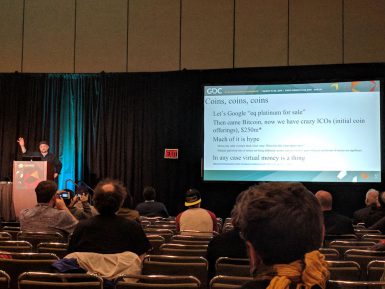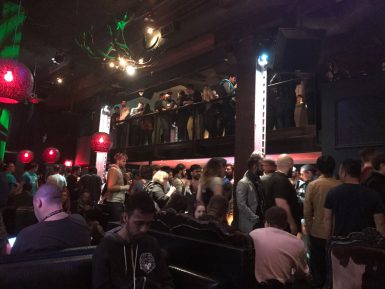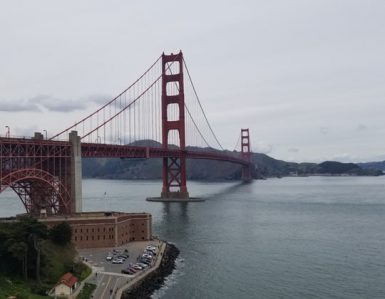Game design students attend Game Developers Conference
Media school game design students James Humphrey, Alex Silvertooth and Devin Good visited San Francisco to attend the 2018 Game Developers Conference. The conference is an annual gathering of programmers, artists, producers, game designers, audio professionals, and business leaders involved in the development of interactive games and virtual reality.
The three students were recipients of the Level Up scholarship, which funded their travel and expenses for the trip. Read more about their experiences at the conference.
Virtual Currency in the Education System
by Alex Silvertooth

At the annual Game Developers Conference in San Francisco, Media School professor Edward Castronova gave a talk discussing the effect of virtual currency in the educational system. Castronova is a professor of game design at The Media School. Inside the game design program, professors and teachers award a virtual currency, called Crimsons, to students who go above and beyond the expectations of an assignment. Students can collect these Crimsons and turn them in for a 24-hour extension on an assignment, use them to bid on items available on Slack, the program’s shared communication channel.
Crimsons can also be used to pay students who are looking for more work inside the game design program. Castronova went on to explain the pros and cons to the system. One pro being it brings the students together, no matter their skill. One con being that teachers, who have an unlimited amount of Crimsons (so they can hand them out), can mess up the Crimson worth by handing them out recklessly, causing an inflation in the virtual currency market.
The full talk will be available at a later date at https://www.gdcvault.com/
Polycount, ArtStation Parties

by Jay Humphrey
By far the most effective networking opportunity I had at the Game Developers Conference were the art parties. There are two parties, hosted by 3D modeling forum Polycount and digital art sharing website ArtStation, which are focused on all forms of game art.
Each party offered a fun, relaxed atmosphere for artists to get to know each other and discuss their craft. What made it such a great networking opportunity for newcomers was the ability to meet people at the first party, then recognize those people at the second. Veterans of the conference were able to already see familiar faces to talk to, but for me it was hugely helpful to be able to recognize people I had met from just two nights before.
Making connections at GDC
by Devin Good

You hear a lot of different points of advice before your first Game Developers Conference: You are going to be overwhelmed, stay out of the Tenderloin neighborhood, it’s a marathon not a sprint, don’t fly Spirit Airlines (for the record, I think Virgin is worse and Tenderloin has great ice cream).
However, none of that quite prepares you for the day the expo floor opens and you see what the “big ones” are working on: virtual reality rigs that are full body suits, graphics so detailed they look like a movie and demos of games that seem to react intelligently to every decision the player makes. It is daunting to see the best of the industry all in one place and to feel like the smallest cog that isn’t even a cog in the machine yet. My first few days there I stayed on familiar ground near the other indie developers (small independent game studios) as they felt more approachable.
What I found was interesting — a fair amount of the people working on their own had worked at the larger studios and did not view them with the same separation I did. And often times, talking with these individuals lead to them introducing me to their friends who worked for larger studios as designers. Now while these meetings didn’t mean a job interview, it was a rush to hear from a successful designer that they are interested in what you are creating.
A favorite part of GDC for me was meeting with speakers after their talks to discuss how they ended up where they are now (Twitter is a great way to reach out to people). This lead to meeting designers of some of my favorite games as a child who inspired me to pursue this career. They treated me as an equal and were excited to see what I was working on to break into the industry as well.
What I found at GDC may not have been any immediate leads to a job, but a diverse community of developers that support each other with friendly rivalries and not the cut-throat industry that I had heard rumor of. I cannot wait to bring my completed game to GDC next year and get feedback from the community that welcomed me so kindly this year.

